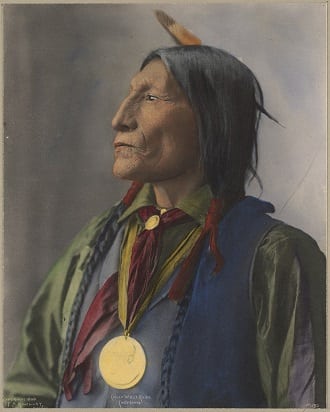
Cheyenne Indian Facts
The Cheyenne Indians were a tribe of Great Plains American Indians who lived in what is now Minnesota, Montana, Oklahoma, and parts of Colorado, Wyoming, and South Dakota. Hunting was extremely important to these people as it provided them with food and materials for clothing, tools, weapons, and their homes. Men and women typically had one or two kids and lived in earthen lodges and later in teepees, where they would gather as a family unit. Read on to find out more about the interesting lives of these Native Americans, rich in history and culture.
Click here for a great selection of Cheyenne Indian books on AMAZONCheyenne Indian General Facts
- Because of their forced relocation by the U.S. government, the Cheyenne consist of two tribes, the Southern Cheyenne and the Northern Cheyenne.
- Because hunting was so important to the Cheyenne, they were able to pack up all of their belongings and disassemble their teepees in a matter of minutes in order to follow a buffalo herd.
- Indigenous to the Great Plains, the Cheyenne often used what is called Plains Sign Language to communicate with other local tribes. To communicate with those in their tribe, the Algonquin language was spoken. Today, most tribal members speak English.
- Roman Nose was one of the most idolized warriors of all of the Plains Indians during the 1860s when the Plains Indian War took place. He was from the Northern Cheyenne tribe and often mistaken for a chief, although he never was one. His size, stature, and air of invincibility made him stand out even among chiefs.
- Like other Indian tribes, the Cheyenne were given reservations by the U.S. government when their land was invaded during the California Gold Rush that began in the 1840s.
Cheyenne Indian Tribal Facts
- Cheyenne Dog Soldiers were a military-driven band of Cheyenne warrior Indians who were known to fight to the death to protect their people. One had to perform incredible acts of bravery to join this honorable group.
- The Cheyenne were friendly with the Lakota (Sioux) and had a long-time friendship with the Arapaho, with whom they even shared territory.
- Beading was the major form of jewelry for the Cheyenne. Because they had to be able to pack up their belongings quickly, they needed an art form that was not breakable or cumbersome.
- Once horses were introduced to what was originally a farming society, the Cheyenne were able to better hunt buffalo. Their main food source changed from vegetables to buffalo meat. They also ate fruits, nuts, berries, and fish.
- The Cheyenne were very religious and ceremonial people. They performed an elaborate sun dance, smoked peace pipes, built houses specifically for ceremonies, and recognized both special hats and arrows as being sacred.
- The practice of counting coup was used by the Cheyenne Indians. This involved acts of bravery and the winning of prestige against an enemy. The greatest honor came from touching the enemy and then getting away unharmed. The enemy could be touched with a hand, a stick, or some other object. Counting coup was practiced by many Plains Indian tribes.
- From an early age, Cheyenne kids learned their respective roles from their parents, although both had time for play as well. Girls would learn how to cook, clean, and take care of the home, including taking the teepees apart to relocate. Boys would learn the skills needed for feeding a family, including hunting and fishing, as well as how to fight in battle.